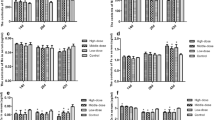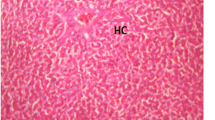Abstract
This experiment was conducted to investigate the oxidative stress in chickens exposed to different concentrations of chromium trichloride (CrCl3) in drinking water. Seventy-two Hylan Brown male chickens were randomly divided into four groups: three experimental groups and one control group. The experimental groups were exposed to three different doses (50 % LD50, 25 % LD50, and 12.5 % LD50) of CrCl3 mg/kg body weight for 42 days, while the control group was given the equivalent water. The activities of antioxidant enzymes (superoxide dismutase, catalase, and glutathione peroxidase) and non-enzymatic index (glutathione, total antioxidant capacity, malondialdehyde, and hydrogen peroxide) were measured after obtaining the brain samples. Results suggested that 50 % LD50 chromium(III) significantly increased (P < 0.05) the contents of malondialdehyde and hydrogen peroxide. The antioxidant enzyme activities, total glutathione concentration, and total antioxidant capacity decreased significantly (P < 0.05) compared with those of the controls and were consistent with the increase in dosage and time. Additionally, extensive histological alterations were observed in the chicken brain, such as the vacuolization and nuclear condensation of the neurons. These results indicated that exposure to high-dose CrCl3 for a certain time could induce the occurrence of oxidative stress and histological alterations.





Similar content being viewed by others
Abbreviations
- CrCl3 :
-
Chromium trichloride
- CAT:
-
Catalase
- GSH:
-
Glutathione
- GPX:
-
Glutathione peroxidase
- GSSG:
-
Oxidized glutathione
- H2O2 :
-
Hydrogen peroxide
- LD50 :
-
50 % lethal dose
- MDA:
-
Malondialdehyde
- ROS:
-
Reactive oxygen species
- T-SOD:
-
Total superoxide dismutase
- T-AOC:
-
Total antioxidant capacity
- TBA:
-
Thiobarbituric acid
References
Yam-Canul P, Chirino Y, Sanchez-Gonzalez D, Martinez-Martinez C, Cruz C, Pedraza-Chaverri J (2008) PJ34, a poly adenosine diphosphate-ribose polymerase inhibitor, attenuates chromate-induced nephrotoxicity. Basic Clin Pharmacol Toxicol 102(5):483–488
Colla LM, Dal’Magro C, De RA, Thomé A, Reinehr CO, Bertolin TE, Costa JA (2014) Potential of live spirulina platensis on biosorption of hexavalent chromium and its conversion to trivalent chromium. wInt J Phytoremediation 17(9):861–868
Laschinsky N, Kottwitz K, Freund B, Dresow B, Fischer R, Nielsen P (2012) Bioavailability of chromium(III)-supplements in rats and humans. Biometals 25(5):1051–1060
Wu F, Sun H, Kluz T, Clancy HA, Kiok K, Costa M (2011) Epigallocatechin-3-gallate (EGCG) protects against chromate-induced toxicity in vitro. Toxicol Appl Pharmacol 258(2):166–175
Furman SC, Goetschel CT, Huc B, Nufert TH (1993) Pharmaceutical insulin-potentiating CR(III) complexes with GTF-like activity. US, US PP5266560.
Lien TF, Wu CP, Wang BJ, Shiao MS, Shiao TY, Lin BH, Lu JJ, Hu CY (2001) Effect of supplemental levels of chromium picolinate on the growth performance, serum traits, carcass characteristics and lipid metabolism of growing-finishing pigs. Animalence 72(2):289–296
Liu T, Wen H, Jiang M, Yuan D, Gao P, Zhao Y, Wu F, Wei L (2010) Effect of dietary chromium picolinate on growth performance and blood parameters in grass carp fingerling, ctenopharyngodon idellus. Fish Physiol Biochem 36(3):565–572
Bona KRD, Love S, Rhodes NR, Mcadory DA, Sinha SH, Kern N, Kent J, Strickland J, Wilson A, Beaird J (2011) Chromium is not an essential trace element for mammals: effects of a “low-chromium” diet. J Biol Inorg Chem 16(3):381–390
Lushchak OV, Kubrak OI, Torous IM, Nazarchuk TY, Storey KB, Lushchak VI (2009) Trivalent chromium induces oxidative stress in goldfish brain. Chemosphere 75(1):56–62
Lushchak OV, Kubrak OI, Lozinsky OV, Storey JM, Storey KB, Lushchak VI (2009) Chromium(III) induces oxidative stress in goldfish liver and kidney. Aquat Toxicol 93(1):45–52
Bai Y, Zhao X, Qi C, Wang L, Cheng Z, Liu M, Liu J, Yang D, Wang S, Chai T (2014) Effects of chromium picolinate on the viability of chick embryo fibroblast. Hum Exp Toxicol 33(4):403–413
Qi W, Reiter RJ, Tan DX, Garcia JJ, Manchester LC, Karbownik M, Calvo JR (2000) Chromium(III)-induced 8-hydroxydeoxyguanosine in DNA and its reduction by antioxidants: comparative effects of melatonin, ascorbate, and vitamin E. Environ Health Perspect 108(5):399–402
Kao Q, Wu K, Li H, Lin Y, Jiang L (2003) The effect of trivalent chromium and hexavalent chromium on the micronuclear rate and the sperm abnormality of mice. Teratog Carcinog Mutagen 16(3):151–154
Shen W, Chen Y, Li C, Ji Q, Li L, Gong C (1999) Effect of chromium trichloride on miotic maturation and in vitro fertilization of mouse oocyte. Chin J Pharmacol Toxicol 14(5):379–382
Baruthio F (1992) Toxic effects of chromium and its compounds. Biol Trace Elem Res 32(1–3):145–153
Goldhaber SB (2003) Trace element risk assessment: essentiality vs. toxicity. Regul Toxicol Pharmacol 38(2):232–242
Dębski B, Zalewski W, Gralak MA, Kosla T (2004) Chromium-yeast supplementation of chicken broilers in an industrial farming system. J Trace Elem Med Biol 18(1):47–51
Fan WT, Zhao XN, Cheng J, Liu YH, Liu JZ (2015) Oxidative stress and hepatocellular injury induced by oral administration of Cr3+ in chicken. J Biochem Mol Toxicol 29:280–287
Liu Y, Liu C, Cheng J, Fan W, Zhang X, Liu J (2015) Growth performance and oxidative damage in kidney induced by oral administration of Cr(III) in chicken. Chemosphere 139:365–371
Hamilton MA, Russo RC, Thurston RV (2002) Trimmed Spearman-Karber method for estimating median lethal concentrations in bioassays. Environ Sci Technol 12(7):714–719
Alshabanah OA, Hafez MM, Al-Harbi MM, Hassan ZK, Rejaie SSA, Asiri YA, Sayed-Ahmed MM (2010) Doxorubicin toxicity can be ameliorated during antioxidant L-carnitine supplementation. Oxidative Med Cell Longev 3(6):428–433
Jena SD, Behera M, Dandapat J, Mohanty N (2009) Non-enzymatic antioxidant status and modulation of lipid peroxidation in the muscles of Labeo rohita by sub lethal exposure of CuSO4. Vet Res Commun 33(5):421–429
Jones DP (2002) [11] Redox potential of GSH/GSSG couple: assay and biological significance. Methods Enzymol 348:93–112
Boşgelmez II, Güvendik G (2004) Effects of taurine on oxidative stress parameters and chromium levels altered by acute hexavalent chromium exposure in mice kidney tissue. Biol Trace Elem Res 102(1–3):209–225
Travacio M, Polo JM, Llesuy S (2001) Chromium (VI) induces oxidative stress in the mouse brain. Toxicol 162(2):137–146
Floyd RA (1988) Oxygen radical-mediated damage to brain tissue. Basic Life Sci 49:1015–1023
Bagnyukova TV, Chahrak OI, Lushchak VI (2006) Coordinated response of goldfish antioxidant defenses to environmental stress. Aquat Toxicol 78(4):325–331
Dimri U, Bandyopadhyay S, Singh SK, Ranjan R, Mukherjee R, Yatoo MI, Patra PH, De UK, Dar AA (2014) Assay of alterations in oxidative stress markers in pigs naturally infested with Sarcoptes scabiei var. suis. Vet Parasitol 205(1–2):295–299
Lin T, Yang M (2007) Benzo[a]pyrene-induced elevation of GSH level protects against oxidative stress and enhances xenobiotic detoxification in human HepG2 cells. Toxicol 235(1–2):1–10
Heidarpour M, Mohri M, Borji H, Moghdass E (2012) Oxidative stress and trace elements in camel (Camelus dromedarius) with liver cystic echinococcosis. Vet Parasitol 187(3–4):459–463
V. P. Palace HSM, Klaverkamp JF (1993) Interactions among antioxidant defenses in liver of rainbow trout (Oncorhynchus mykiss) exposed to cadmium. Canad J Fish Aquat Sci 50(1):156–162
Thamilselvan S, Byer KJ, Hackett RL, Khan SR (2000) Free radical scavengers, catalase and superoxide dismutase provide protection from oxalate-associated injury to LLC-PK1 and MDCK cells. J Urol 164(1):224–229
Chandran R, Sivakumar AA, Mohandass S, Aruchami M (2005) Effect of cadmium and zinc on antioxidant enzyme activity in the gastropod, Achatina fulica. Comp Biochem Physiol C Toxicol Pharmacol 140(3–4):422–426
Hassan HA, El-Kholy WM, Nour SE (2014) Proanthocyanidin as a cytogenetic protective agent against adverse effects of plant growth regulators supplementation in rats. Cytotechnol 66(4):585–596
Acknowledgments
The study was supported by the earmarked fund Shandong Modern Agricultural Technology and Industry System (No. SDAIT-13-011-04).
Author information
Authors and Affiliations
Corresponding authors
Ethics declarations
Conflicts of interest
The authors declare that they have no conflicts of interest concerning this article
Rights and permissions
About this article
Cite this article
Cheng, J., Fan, W., Zhao, X. et al. Oxidative Stress and Histological Alterations of Chicken Brain Induced by Oral Administration of Chromium(III). Biol Trace Elem Res 173, 185–193 (2016). https://doi.org/10.1007/s12011-016-0640-4
Received:
Accepted:
Published:
Issue Date:
DOI: https://doi.org/10.1007/s12011-016-0640-4




